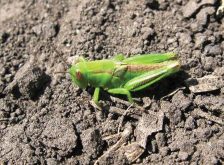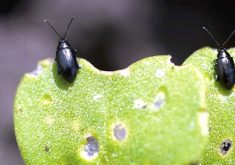Loads of grain across the Prairies are being rejected as a result of insect contamination — but that’s pretty much par for the course at this time of year.
“It’s something that’s actually pretty commonplace, so it’s not too surprising to hear,” said Brent Elliott, infestation control and sanitation officer with the Canadian Grain Commission.
During a “somewhat normal harvest” — like the one growers saw this year — grain goes into the bin warm, said Elliott.
“That’s reasonable. It’s warm outside. The bin’s warm. Everything’s warm,” he said.
Read Also

Mosquito-borne virus could be devastating to sheep breeding operations
Cache Valley virus, a mosquito-borne disease that infects small ruminants, could be a devastating hit to small operations.
“But people tend to forget to get their aeration on there, and they tend to not cool down their grain. They think, ‘Well, winter is coming, so it’s OK. The grain will cool down anyway.’”
That does happen to a degree but in many cases, the core of the grain stays “very, very warm,” and any insects that were in the bin prior to harvest or that came in during harvest will survive and thrive in that warm core.
“The insects stay quite happy and quite alive in that bin,” said Elliott. “The insects we’re most concerned with — which we call primary insects — are insects that feed directly on grain. If they’re alive, they’re actually feeding on the grain, and they can reduce the quality and the quantity of the grain.”
And if there are enough insects, they can perspire “quite a lot” and mould will develop.
“That leads to some pretty nasty grain that nobody really wants.”
So when grain terminals reject a load of insect-infested grain, they’re trying to prevent losses in both grain quality and quantity, said Elliott, adding the commission has a zero-tolerance policy for live insects.
“Technically speaking, you’re not allowed to move or accept grain that is infested. When you hear of an elevator rejecting a load of grain that has insects in it, that is in fact exactly what they’re supposed to do.”
But producers can avoid having loads rejected, by aerating their grain and “it’s a good idea to do that now,” said Elliott.
“It’s always a good idea to have the aeration on your grain when it’s in storage,” he said. “That should happen a little sooner than most people think in the fall, when the temperature starts dropping below 15° at night.”
Insects aren’t feeding or reproducing when the temperature is below about 15 C to 18 C, he added. But that’s the temperature of the grain in the bin, not the outside air.
“If you can get your grain temperature down below 15 C, it’s not necessarily going to kill those insects, but it will keep them from increasing in numbers and it will certainly stop any feeding that they’re doing.”
Coring the bin can also help with aeration and weekly monitoring is recommended. When core temperatures get too high, producers can core their bin by putting a paper towel on top of the grain and augering it out at the bottom into a truck. When the paper towel comes out, the bin is cored, and the grain can cool in the truck overnight.
Be wary of fumigation, Elliott added.
“It’s a safety concern at this point in the year,” he said.
Producers typically fumigate with phosphine gas pellets, which release phosphine gas slowly in the right temperature and moisture conditions (typically with a grain temperature no lower than around 10 C).
“If it’s too cold in the grain, those tablets won’t actually form the gas. They’ll just sit there, and they’ll sit there until the grain warms up in the spring,” he said.
“We’ve heard stories of people going to their bin and getting a face full of phosphine gas when they open the top of the bin.
“We want guys to be really, really careful with that.”
And if the tablets remain undissolved, that leads to a whole other set of problems, added Elliott.
“If guys think grain elevators are unhappy seeing insects in grain, wait until they try to deliver undissolved phosphine pellets.”















